Keys for Teaching Each Volleyball Skill
WHAT ARE KEYS?
- Keys are shared traits that almost all top performers of each skill have in common
- To help memory, keys are best used as short phrases that are connected to a larger concept
READY POSITION
Head Up
- Shoulders back
- Eyes Alert & Tracking
Ready to Move
- Medium-height
- Bent hips, knees and ankles
- Weight is slightly forward, on the balls of the feet
- Feet are hip distance apart, slightly staggered
Loose Arms
- Hands faced up, ready to react
MOVING KEYS
Principles
- Keep your head (and eyes) at the same height as you move
- Step first with the foot closest to the ball
- Being balanced is more important than being stopped
- Finish moving with a T stop (small hop to have feet slightly wider than hips and slightly staggered, balanced)
Moving Forward
- Run, using your arms
- Run, using your arms
Sideways/Diagonally
- Shuffle like a crab
- Don’t cross feet over each other
- Keep hips facing back to the court
Backward
- Backpedal or turn and run
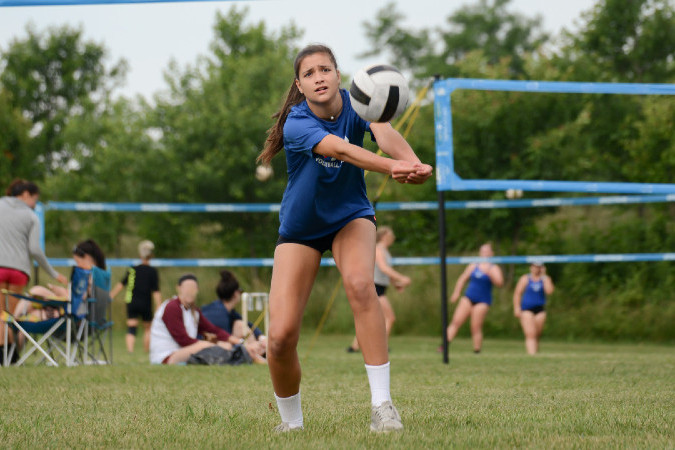
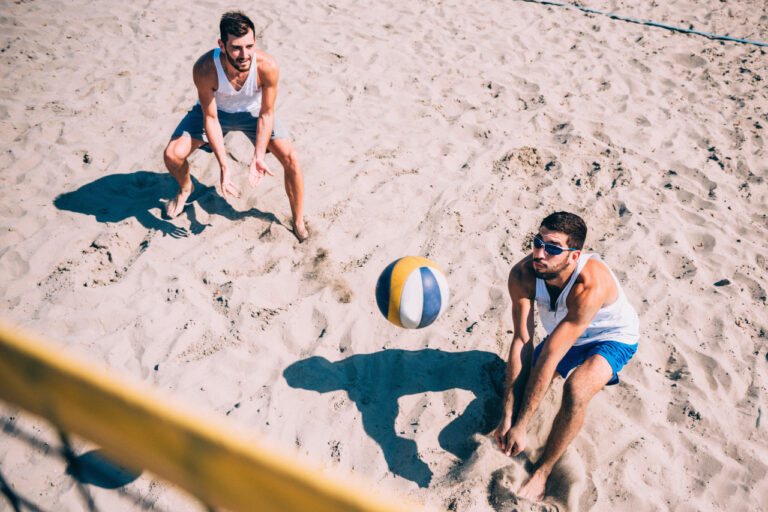
PASSING KEYS
Principles
- As little movement as possible
- Pass the ball up, not forward – ball arcs and lands on the target
- Aim for a small target
- Make it look easy – think “smooth”
- Pass with no rotation on the ball
- Breathe out as you pass to relax muscles
- Empower them to be athletic and not be afraid to look stupid
- “Find the angle”
Platform
- Fingers overlap each other perpendicular
- No fingertips peeking out
- Thumbs are even and pressed together
- Arms stay straight
- Elbows locked
- Shoulders shrug slightly forward
- Create a platform away from body
- Fingers overlap each other perpendicular
Passing
- Contact ball between wrists and elbows
- Face the ball, angle platform to target
- Loose and relaxed shoulders
- Separate arm movement from rest of body
- Feet are stopped & balanced (T-stop)
- Hold finish
- Check form and fix yourself
SETTING KEYS
Principles
- Legs/body bent at 25%
- Arms up at 90 degrees (T-rex arms)
- Be an athlete first, then a setter
- Get to the target, then get to the ball (don’t combine)
- Start facing the passer; be square to target before setting
- Hands up early, tracking volleyball through “window”
- Soft but firm hands
Hands
- Thumbs and index fingers form a triangle
- Hands in the shape of a volleyball
- Loose, springy wrists
- Wrists hinge back as ball comes into hands, than spring forward
- “Neutral, load, neutral”
- Contact ball above forehead
- Be able to see underneath the ball
- Arms evenly extended
- Palms to target
- Thumbs and index fingers form a triangle
Footwork
- Tempo into the ball
- Time the ball contact with your forward momentum
- Use legs and core to increase power
- Releasing from position 1
- Right, left, shuffle, shuffle
- Releasing from position 4
- Right, left, right, shuffle, shuffle
- Tempo into the ball
ARM SWING KEYS
Principles
- Elbow pulls back perpendicular
- Upper body opens and torques
Hitting Motion
- Arms Come Up Together
- Simulates jumping motion
- Arms Separate
- When arms get to chest level
- hitting elbow pulls back
- chest opens up
- non-hitting hand goes up and tracks the ball
- When arms get to chest level
- Shoulders Tilted
- Non-hitting shoulder is slightly higher than hitting shoulder
- Shoulders are in a straight line
- Engage Core
- Hips starts to turn forward
- Elbow Circles Up
- Hitting hand rotates around ear
- Hitting elbow comes up and leads forward
- Non-Hitting Arms Tucks
- Tuck non-hitting arm to center of body
- Arm Whip Forward
- Arm whips forward
- Shoulders tilt – hitting shoulder now higher than non-hitting shoulder
- High Contact
- Loose wrist snaps over ball
- See the hand break over the ball
- Middle finger directs where the ball will do
- Hit Through the Ball
- Hitting arm follows through either side of body
- Arms Come Up Together
LANDING KEYS
Principles
- Land softly
- Land quiet and balanced
- Softly contact ground with feet at same time
- Absorb force with bent ankles, knees, hips
- Hips over ankles, and shoulders over hips
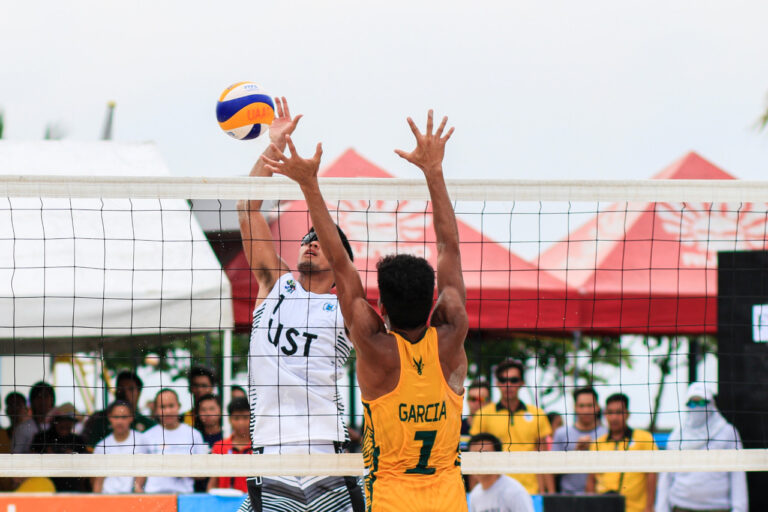
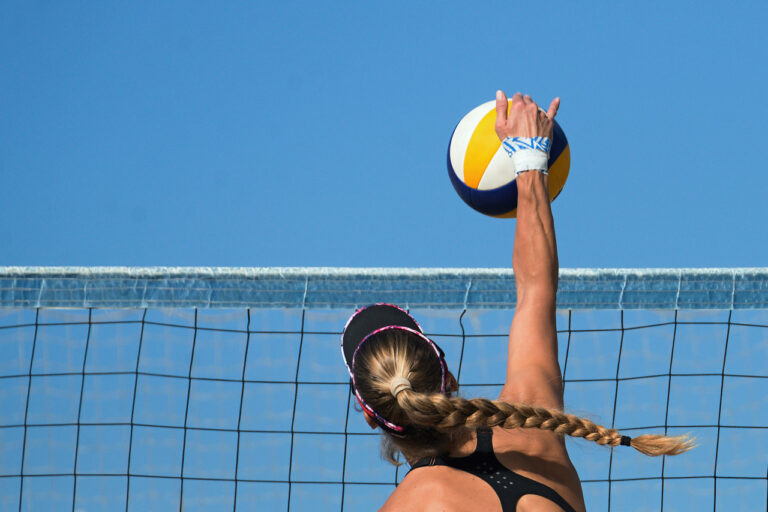
HITTING KEYS
Principles
- Jump up, not forward
- Convert horizontal energy into vertical energy
- Small to big steps
- Slow to fast steps
- Plant feet behind the ball
- Get up in the air fast after planting (use quick twitch muscles)
- See your hand break over the ball
- Hit through the ball
- It should feel like you are late to the ball
- Middle finger guides the ball
2-Step Approach (Righty)
- Both arms swing back as the right foot takes a big, aggressive step forward and plants at 45 degree angle
- Left foot plants quickly next to the right foot
- Arms swing up together and helps lift the body up in the jump
- Player gets into the “throwing position” in the air
4-Step Approach (Righty)
- Small, slow first step (start building momentum)
- Slightly bigger second step (toward the ball)
- Big, aggressive, and fast third step, right foot planting facing Zone 5
- Fourth step – left foot plants quickly next to the right foot
- Arms swing up together and helps lift the body up in the jump
- Player gets into the “throwing position” in the air
DIGGING KEYS
Principles
- Digging target:
- 5′ higher than the antennae
- 5′-10′ off the net
- Never overpass a dig
- Tips should be treated like digging a regular attack
- Hips must be lower than the ball on contact
- Digging target:
DOWN!
- Right before hitter contact the ball, pick your digging spot and do a finishing hop to get feet wide and body low
- Be completely stopped and balanced when the hitter contacts the ball
- Weight is slightly forward on the balls of the feet
- Hands over knees, facing up, ready to react
- Right before hitter contact the ball, pick your digging spot and do a finishing hop to get feet wide and body low
Be Calm
- Be calm and still on contact
Hold Finish
- After digging, hold passing platform for an extra second
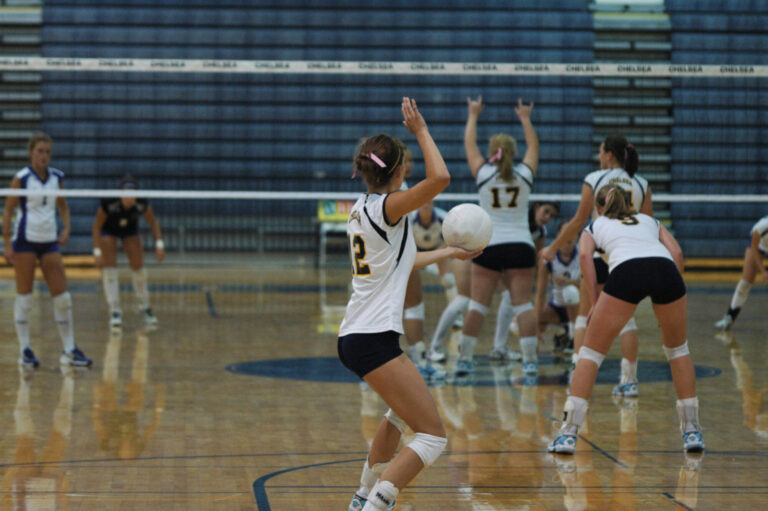
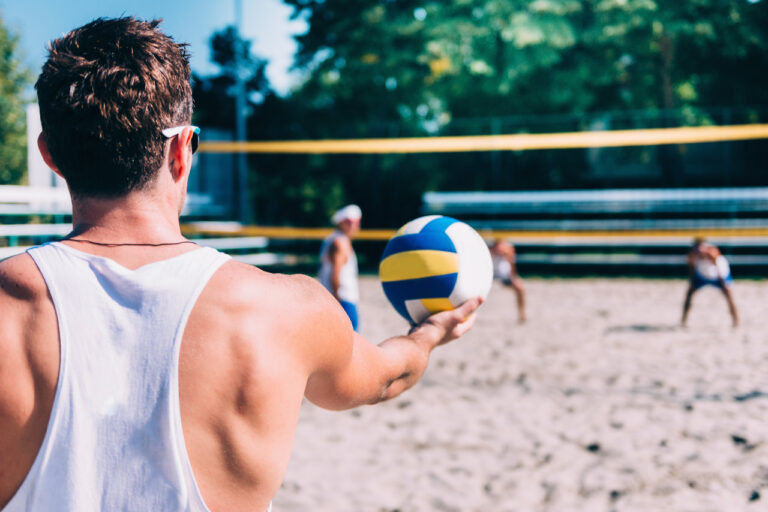
SERVING KEYS
Principles
- Routine
- A short and simple routine to get your mind focused on the serve
- Taking a deep breath must be included in this routine
- Visualize
- Visualize your body’s movements and the ball’s flight path as specifically as possible
- Literally see the result you want in your mind’s eye
- Small Target
- Aim for a specific target
- The smaller the target, the smaller it will miss
- Never aim for “just over the net”
- Process Feedback
- After each serve think about where the ball went, how you contacted the ball, and how to improve the next serve
- Every Serve is Your Best Serve
- Serving is the one skill in volleyball you have complete control over
- Routine
Toss
- Player’s body starts at 45 degrees from the net
- Non-dominant foot is closer to net
- Hitting arm starts back at 90 degrees
- Hand up
- Chest open
- Non-hitting hand palm up holding the ball, with elbow slightly bent and ball directly in front of hitting shoulder
- Place ball in air
- 2” higher than your ear
- Ball should hang suspended in the air before contact (no drop)
- If the ball were to land, it would land next to your stepped foot
- Step forward
- Push off the back foot and shift body weight forward
- Step forward with non-dominant foot, engaging core and turning hip around to generate power
- Player’s body starts at 45 degrees from the net
Contact
- Hitting arm and hand start relaxed
- Hand and wrist stiffens on contact with ball (like a high-five)
- Contact with the heel of the hand (the bony, hard part at bottom of the palm)
- Contact in the very center of the ball
- Wrist directs the ball where to go
- Arm hangs in air after contact and doesn’t follow through
- No spin
- Try to serve with no spin on the ball
- If there is rotation on the ball, the wrist broke over it in that direction
- Hitting arm and hand start relaxed

JUMP SERVING KEYS
Principles
- Jump serves aren’t inherently better than standing serves
- Jump into the court
- Tempo into the serve
Jump Float
- Starting position is the same as the standing float serve
- Hitting arm back and loaded
- Non-hitting arm holding ball in front of hitting shoulder
- Use the same footwork as a four-step hitting approach
- Not jumping for max height
- The toss can be either before or after the 2-step plant (whichever feels better for the player)
- Right, left, TOSS, right left
- Right, left, right left, TOSS
- Starting position is the same as the standing float serve
SERVE RECEIVE KEYS
Principles
- Do 75% of the work done before the ball crosses the net
- Never get aced
- Read server’s shoulders and contact angle off their hand
- Better the ball
- If it is a tough serve, just get it up
- If it is a managable serve, make it a perfect pass
- See the ball and react with your FEET early
- Quick and clear communication between passers is critical
- Always be prepared for your teammate to shank the pass
Eyes on Server
- Don’t be caught surprised by a quick whistle
- Call out where the server is serving from
- Recognize and call out server’s habits and body language
Three Steps
- Start moving to the ball right after contact
- Move on a diagonal, stepping in front of other players if needed
- Track the ball with your eyes right to your platform
Calm
- Lower body does most of the work to get platform in the good position
- Arms and hands are ready to react to last minute angle changes
Hold Finish

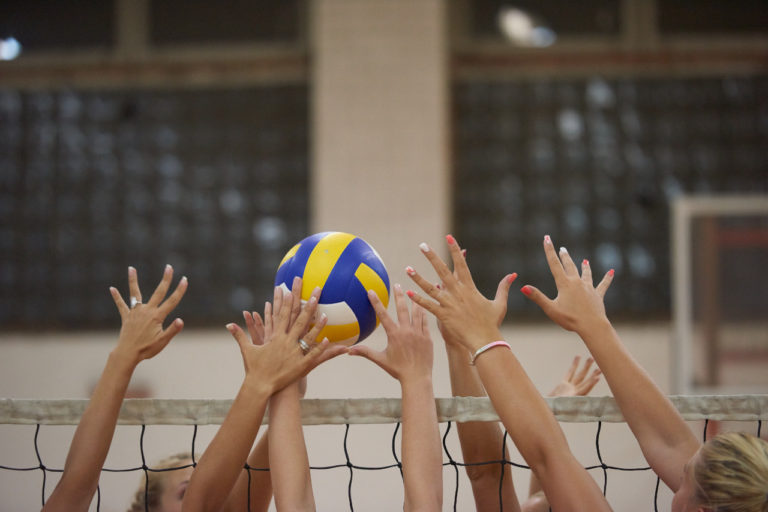
BLOCKING KEYS
Principles
- Get hands pressed over the net as soon as possible, as far as possible, for as long as possible
- Hands go small to big
- Angle arms and hands back to the middle of the court (zone 6)
- Squeeze your core during every block
- Time your jump based on the hitter’s attack
- Keep shoulders square to the net before jumping
- Land with both feet softly and balanced
Functions of Blocking
- Intimidation
- Force the hitter to hit where you want the ball to go
- Positive touches – reduce speed of attacks
- Block the ball back into their court/block kills
Base
- Bunch – Pin hitters are arm distance from middle hitter
- Spread – Pin hitters are arm distance from each antennae
- Arms are ¾ distance from net, shoulders below bottom of net
- Hands open and showing through the net, left thumb at 1 o’clock, right thumb at 11 o’clock
- Weight on balls of feet ready to react
Eyework & Movement
- Platform, hands, hitter
- Read the setter and anticipate the set’s direction
- Jab step, shoulders stay at 45 degrees, load arms to swing up
- Attack the hitter – step into the hitter’s line of attack
